Making A Bucket List
 He who doesn’t fear death dies only once. ~Giovanni Falcone
He who doesn’t fear death dies only once. ~Giovanni Falcone
I woke early this morning – around four o’clock. This is not unusual for me, but I’ve been sleeping much better since we moved back home. It runs in my family, this insomnia thing. We rise and look for books in the middle of the night, scan the million and one channels on television only to find nothing worth watching, and we wrestle with mind monsters who refuse to go away. It is our way.
What do we think about when the rest of the world is asleep? On this particular morning, I’ve been thinking about making a bucket list. Remember that movie with Morgan Freeman and Jack Nicholson? Two cancer patients take off for parts unknown to fulfill their “life list” or “bucket list” before time runs out.
It seems I’m not original in this thought. I googled “bucket list” and got 46,000,000 results. Is that really possible? So what do people put on their bucket lists? I’m sure that creating a few categories would stimulate the fantasy button – travel, career, family, etc. Is there any endeavor in the world that can not be expedited by categorization? Spoken as a true “A” type personality.
Travel seems to be a big part of what people feel they’ve missed out on. Many of us procrastinate when it comes to visiting the Grand Canyon, or the Taj Mahal. There will always be time and money to do it later, but upon our first breath that hour glass turns over, and those grains of sand never stop sifting downward till our last hour. The Smithsonian has even made a list of the 28 Places To See Before You Die. Now that’s putting a fine point on it.
I am beginning to think maybe I should do this thing – this bucket list. So as not to forget what it is that I truly want out of life or wait till it’s too late, it might not be a bad idea. Why not give some thought to what I’d like to do before time really does run out. I’m pretty sure it won’t be extensive travel though. I enjoy a little travel but not as much as most.
I have a feeling that my list would be quite boring to most. Though I know and understand why others enjoy travel and adventure, I enjoy small pursuits. So most of them are within my grasp financially and physically. How fortunate am I? Fortunate that I have what I wish, and that (for the most part) I wish for what I can have. Still, a bucket list might help me focus on what matters most, but I’m pretty sure it won’t be visiting the Taj Mahal. Maybe the limestone cliffs in Thailand where those millions of wrinkle-lipped free-tailed bats fly out at sunset and return at sunrise. They say it’s quite a sight.
What is your heart’s desire? Do you have a bucket list?
Small Home Offices

Image:Homes and Gardens
My husband and I have been toying with the idea of downsizing for a while now. We’re still young enough to lead the lifestyle of the healthy and active, but we are actually beyond the empty nester period of life. Our son left home for greener pastures a decade ago.
We now have the luxury of time and the boon of good health, but our house is quite large and two stories. What was once our idea of the near perfect house is now more than we want to take care of. We’re interested in travel, spending time with grandchildren and friends, and enjoying the increasing cultural growth in our city.
After a considerable absence from this house, the past few weeks have found us involved in numerous endeavors devised to reclaim our long empty house. As we’ve painted a peeling bench, swept and power washed the porch and deck, or pulled weeds from the neglected flower beds, we’ve mumbled too one another about downsizing, lower maintenance, a simpler and more manageable life.
As we’ve pitched old clothing, books, deck furniture, and numerous other items we no longer need, we’ve chatted about what kind of house we would like for this next stage of our lives. What exactly do we want in our next house. Perhaps even more importantly, what can we give up?
We now live in a four bedroom house. My office is set up in what would have been a small bedroom, and my husband enjoys a room designated as a gym. Maybe our next house will have an unfinished attic space or basement that can be transformed into a gym. Perhaps there will be a large closet or small nook that can serve as an office space for me. Do I honestly need an entire room? I’m willing to give up a little space to get a one story house that will offer the ease of living we’re seeking at this point in our lives.
This train of thought sent me looking for ideas about space saving home offices this morning. I mean, how much space is actually needed for an efficient office? What is the least amount of space in which I could comfortably and effectively work? I think I’ll be exploring these questions and more in the not too distant future.
An efficient use of space tucks this home office into a second-floor landing. (Country Living)

And what about this idea (from Small Places)? What could require less space than housing it all in one piece of furniture?
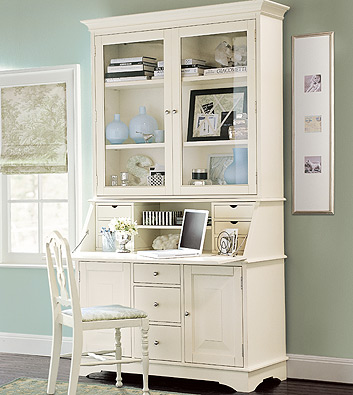
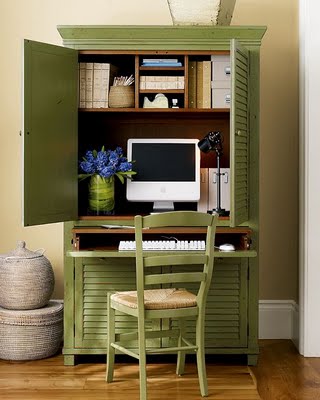
A neglected nook becomes usable workspace in HGTV’s Dream Home 2006.
And then there’s the clever tuck-it-into-a-guest-bedroom trick. (Country Living)

And last but not least, the old office-in-a-closet idea. BHG

Tips For Home Offices In Small Spaces
- rolling bins under the couch or bed
- a wheeled cart that hides under the desk
- a dresser or credenza with room for office supplies and visitors’ belongings
- leather- or fabric-covered boxes, pretty file holders
- woven baskets on a bookshelf to house rolled-up towels, bath salts and magazines for guests
- two-drawer filing cabinets covered with fabric that double as side tables and nightstands
- purge every thing you can do without and then purge some more
Confessions from a fat girl’s closet…
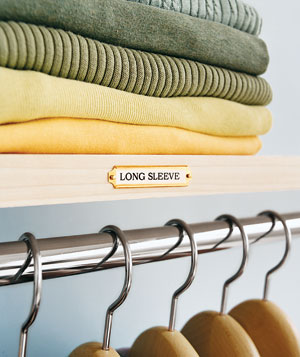 Photo: Real Simple by Scogin Mayo
Photo: Real Simple by Scogin Mayo
I had to write this post, if for no other reason than to use that title. It’s been rambling around in my head for a few days now.
After spending the past few weeks doing long needed yard work, repairs, painting, etc. around this pitifully neglected house, I finally decided to brave the scariest task of all! Every woman knows what I’m talking about. That would be the dreaded closet rehab.
Due to family considerations, we spent the last three years in another city. We’ve returned to a house which is now afflicted with a bagful of maintenance avoidance issues. Don’t you just love that overblown phrase – maintenance avoidance issues ? It sounds like the psycho babble of a home maintenance shrink. Anyway, whatever you want to call them, we have a ton of these niggling issues that have festered under our three year policy of benign neglect. They are exactly the type of problems you would expect to crop up when homeowners are suffering from the too-much-on-your-plate-syndrome. Another one of my fancy diagnoses.
So the things that usually take precedence immediately following a move were not at the top of our list. We found ourselves holding our fingers in the dike to stem the flow of decrepitude around here, while simultaneously shoring up all the little things that were screaming for attention. Unpacking boxes, cleaning closets, etc. were not priorities.
This finally brings me to the subject which the title of this post implies. Yes, I’ve finally gotten down to the business of the horror that is my closet. ‘Tis a woeful tale I tell you, and a confession that is even more shameful when I admit that we had only lived in this house four years before we moved away for three years to help a sick family member. In other words, we had moved from another house only four years before, and I had discarded all that I thought unworthy of the move. Theoretically, this closet should only house things that I thought worthy of making the move at that time. Ha!
I will not divulge all here. Let us not discuss the shoes. Oh, look away! The shoes alone would bring a tear to your eye. And I can not admit to the brand spakin’ new suit, never worn, tags still dangling from its exquisite sleeve – two sizes ago when Weight Watchers was still a part of my life. Now it just hangs there, protected by nothing more than an old and dusty garment bag.
*clearing the throat and dabbing the eyes*
And I can’t forget that uncomfortably small dress coat with classic lines that I loved so much – very old but like-new. I gave it to Goodwill. And hats! I don’t even like hats. Who knew I could have so many hats? Not me. Six stuffed-to-bursting garbage bags later – four for Goodwill and two for the dump – my closet still is not what I want it to be.
Seriously, women who, um, fluctuate in size and weight have certain closet anxiety challenges that others do not. It just doesn’t feel right to pitch perfectly good clothing that is good-as-new, only it’s the wrong size. The guilt alone is sometimes enough to force me to put it back on the hanger, and place it in the closet for another few years, telling myself the big lie, Maybe I’ll lose enough to wear it someday. I try to convince myself that someone else will find it to be useful, but it still feels like waste and excess to me.
So this is how I’ve been spending the past few dark and rainy days. As raindrops drizzle down my windowpanes, to chase the shadows away, I switch on a small light that sits on the dresser, and I remind myself to be merciless. I tell myself to let go of the red blouse my sister gave me. She passed away a few years ago, and I counsel myself to keep the memory but release the blouse. Keep the good feelings but give up the stuff. I’m following through on my promise to myself about letting go of the clutter, and I’m making a new promise to myself to buy less, to buy only what I need, and to be more respectful of all that I have.
But I have to tell you, there has been much conjecture amongst the neighbors about the mournful wails escaping my bedroom walls.
Check out Real Simple’s 31 ways to make over your closets.
Here’s another article you may enjoy from ZenHabits on How to Declutter.
Where the heart resides…
 We’ve recently moved back to our own home following a three year absence. Our house has been sorely neglected for those years, and I’ve learned that neglect can wreak havoc on even a fairly new house. Like people, houses need regular doses of TLC.
We’ve recently moved back to our own home following a three year absence. Our house has been sorely neglected for those years, and I’ve learned that neglect can wreak havoc on even a fairly new house. Like people, houses need regular doses of TLC.
The last two weeks have included repairing, scraping, painting, replacing, hammering, nailing, power washing, etc. A lot of work remains to be done, but we have time. We even plan to take a small vacation this fall, the first in a long while. Beauty and relaxation is what we’re looking for, a refilling of the cup. We thought a drive up to New England for a few days would be just the thing, and along the way, a very brief stop just to peek in on our grandchildren.
Most of our work has been basic in-the-trenches maintenance, but we did do one purely decorative project – albeit a very small project. I convinced my husband to stop weeding flower beds, replacing a garbage disposal, and painting porch railings long enough to hang a few photos in the office. You’ve already seen the results above.
For the moment, we’re enjoying the simple pleasure of being home. The mundane tasks of unpacking boxes, cleaning closets, making trips to the dump, and even washing laundry bring contentment these days. We’ve truly missed our house, our neighborhood, and most of all, our friends. Though it may be a cliché, home truly is where the heart is.
8 Surprising Ways to Save Your Credit Score
 What you don’t know about credit cards can hurt you. So read on for smart ideas to help get the numbers going your way.
What you don’t know about credit cards can hurt you. So read on for smart ideas to help get the numbers going your way.
iStock Photo
by Dave Baldwin
Source: Real Simple
1. Use your credit cards.
Why: Paying in cash and rarely using credit cards may be a point of pride for you, but it isn’t a good move for your credit score. As a result of the credit crisis, companies that once would have left inactive accounts open and tried to lure you back are now quick to close “sock drawer” cards. “Inactive accounts are unprofitable for credit-card companies,” says Liz Pulliam Weston, the author of Your Credit Score (FT Press, $19, amazon.com) and a personal-finance columnist for MSN Money. “Now it’s use it or lose it.” While you may not mind losing a seldom-used card, there’s more serious fallout: Because 30 percent of your score is based on your debt-to-credit-limit ratio―the gap between what you owe on all credit cards and your total available credit―having one account closed increases that ratio and thus lowers your score. So use your cards, says Weston: “Regular, responsible use will help to maintain and improve your score.” If your card is canceled for nonuse, it’s difficult to get your account reopened. You can try by placing a call to the credit-card company and highlighting your stellar payment history, says Sheri L. Stuart, education manager for Springboard Nonprofit Consumer Credit Management, in Riverside, California. But you will have to go through the application process again.
2. Pay off the lowest-balance credit card first.
Why: If you’re feeling overwhelmed by credit-card debt, you may find it hard to stay motivated to keep up a serious repayment effort. While paying off the highest-interest card first will save you the most money in the end, the boost you get from quickly knocking off the lowest-balance card may be more instrumental in keeping you on track. Instead of spreading your monthly payments equally among credit cards, “snowball” your debt, advises Lisa Ray, a financial-education specialist at the Consumer Credit Counseling Service of Greater Atlanta. With this method, you pay down the lowest-balance card first and pay minimum balances on the rest; as each card is paid off, apply the money you would have paid on it to the next-lowest-balance card, and so on. (If you also have other debt, Ray suggests starting with credit cards before moving to secured debt, like car loans and mortgages.)
3. Pay annual fees on a rewards card.
Why: There are plenty of rewards cards out there that don’t charge annual fees, but paying one can make sense. In the end, a card with a fee and good benefits that suit your lifestyle may save you much more than a no-fee card you’ll use less. In weighing a card’s merits, try to project which benefits you’re more likely to use in a year. If the rewards (free hotel nights, discounted movie tickets, cash back into your child’s college savings account) total more than the card’s annual cost―and more than what you would save with a no-fee card―it’s worth the expense.
4. Don’t consolidate credit-card balances on an introductory interest-free card.
Why: “Balance transfers can work in your favor if the interest you save outweighs the transfer fees,” says Leslie McFadden, a credit columnist for Bankrate.com. Otherwise, when the low introductory rate goes up, possibly to more than that of the card you’re transferring the debt from, you may end up paying more interest than you would have on the original card. Also, “you have to be careful that you’re not running up so much of the new card’s credit limit that it’s hurting your score,” says McFadden. Consolidating multiple balances on a lower-limit card, Weston explains, can make it look to the credit bureau like you’re close to maxing out that second card (using most of your available credit limit), which is frowned upon.
Timekeepers Of Old
I found the following plate clock project on Martha Stewart. I like it because I have several mismatched antique plates around here that are hiding in drawers and cabinets as we speak. The beauty of this project is how it repurposes a lovely object, how it creates a unique but inexpensive gift, and of course, how simple it is to make. Martha does keep it simple on occasion.
—————————-

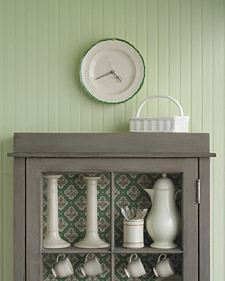 Instead of stashing away a mismatched plate because it doesn’t have a place at the dinner table, put it on display. Using a battery-operated clock mechanism, you can turn an antique separated from its set into an unexpected timekeeper to hang on the wall or stand on a table. Thus reimagined, the dish will serve a purpose not only during mealtimes, but all day long.
Instead of stashing away a mismatched plate because it doesn’t have a place at the dinner table, put it on display. Using a battery-operated clock mechanism, you can turn an antique separated from its set into an unexpected timekeeper to hang on the wall or stand on a table. Thus reimagined, the dish will serve a purpose not only during mealtimes, but all day long.
Plate Clock How-To
In addition to the plate and the clock kit (available at crafts stores and through online clock-parts suppliers), you’ll need:
Ruler
Felt-tip pen
Drill
Masonry bit
Fine-grit sandpaper
Latex paint
Mounting hardware or a plate stand
1. Set plate face down on a soft work surface, such as a folded towel. Use a ruler and a pen to find and mark the center point. Using a drill fitted with a masonry bit, carefully drill at low speed through the point.

2. You can customize clock hands, which come in dozens of styles and sizes, to match your dish. Lightly sand the surfaces with fine-grit sandpaper to help them hold paint. Paint hands in a coordinating shade. To create a distressed look, lightly sand again after the paint has dried.

3. Attach the clock mechanism and hands according to the manufacturer’s instructions. Hang clock, or display in stand.

Cooking Oils Guide

I’ve been giving quite a bit of thought to cooking oils recently. My 92 year old father grew up with saturated fats and continues to consume substantial amounts of fried foods. Unlike most of us, he seems to have escaped the deleterious effects from this – almost century old – practice of abuse to his body. It’s kind of amazing, but I would not recommend his proclivities to anyone who is seeking a healthy diet. I can only imagine that there were other factors that contributed to the longevity and high quality of life he has enjoyed.
He and my mother always had a garden. We ate fresh vegetables in the summer. During the winter months we ate many of those same vegetables which my mother had spent the summer months canning in a small, airless, and hot kitchen. Dad also loved fish and ate a lot of it, and they consumed very little of the preservatives, chemicals, and hormones that we find in our food today, but I truly believe that he was also blessed with wonderful genetics.
After cooking for Dad over the past three years, I’m ready for healthier foods. You can imagine how difficult it is to maintain a healthy weight while eating fried foods several times a week. This is the thought process that led me to look for a primer on healthy oils. After three years of sketchy eating habits, I’m eager to embrace a healthy routine once again – diet, exercise and reduced stress. Sounds good, doesn’t it?
In that endeavor, I searched for a guide on cooking oils this morning and found one at Eating Well. The following is the result of my effort.
All oils have something to offer. Choose according to your needs and preferences.
A well-stocked kitchen includes a variety of different oils chosen for characteristics like cost, smoke point, nutritional profile and culinary uses.
Regardless of which cooking oil you select, be proud of choosing a liquid over a solid fat, such as shortening or butter. It’s a fairly safe bet that by doing so you avoid saturated animal fats and trans fats, the undeniable nutritional bad guys.
Numerous studies confirm that a high intake of saturated fats and trans fats can cause cholesterol and heart-disease risk to rise—and that when unsaturated fats replace saturated fats in the diet, those risks are largely averted.
Use this guide to pick the right oil for your cooking and health needs.
Almond
Monounsaturated: 65%
Polyunsaturated: 28%
Saturated: 7%
Omega-3s: n/a
Smoke point: high
Cost: $$
Comments: Good source of vitamin E.
Avocado
Monounsaturated: 65%
Polyunsaturated: 18%
Saturated: 17%
Omega-3s: n/a
Smoke point: high
Cost: $$$
Comments: Contains vitamin E and heart-healthy phytosterols.
Canola
Monounsaturated: 62%
Polyunsaturated: 31%
Saturated: 7%
Omega-3s: Check +
Smoke point: medium-high
Cost: $
Comments: A top pick (see below). Fair source of omega-3s.
Coconut
Monounsaturated: 6%
Polyunsaturated: 2%
Saturated: 92%
Omega-3s: n/a
Smoke point: medium
Cost: $$$
Comments: High in saturated fat but of a more benign type. Sweet.
Corn
Monounsaturated: 25%
Polyunsaturated: 62%
Saturated: 13%
Omega-3s: Check
Smoke point: medium
Cost: $$
Comments: Heart-healthier, high-oleic versions coming soon.
Flaxseed
Monounsaturated: 18%
Polyunsaturated: 75%
Saturated: 7%
Omega-3s: Check++
Smoke point: no heat
Cost: $$$
Comments: Heat-senstitive: buy “cold-pressed” and refrigerate.
Grapeseed
Monounsaturated: 17%
Polyunsaturated: 73%
Saturated: 10%
Omega-3s: n/a
Smoke point: medium-high
Cost: $$
Comments: High in vitamin E, but also omega-6s. Light taste.
Hazelnut
Monounsaturated: 82%
Polyunsaturated: 11%
Saturated: 7%
Omega-3s: Check
Smoke point: high
Cost: $$$
Comments: Vitamin E source, high smoke point, but heat traps flavor.
Hemp
Monounsaturated: 15%
Polyunsaturated: 75%
Saturated: 10%
Omega-3s: Check+
Smoke point: medium
Cost: $$$
Comments: Has anti-inflammatory fatty acids. Refrigerate.
Macadamia nut
Monounsaturated: 84%
Polyunsaturated: 3%
Saturated: 13%
Omega-3s: Check
Smoke point: medium-high
Cost: $$$
Comments: Rich in antioxidants. Sweet, bold flavor.
Olive, extra-virgin
Monounsaturated: 78%
Polyunsaturated: 8%
Saturated: 14%
Omega-3s: Check
Smoke point: medium-high
Cost: $$
Comments: A top pick (see below). One downside: low omega-3s.
Palm
Monounsaturated: 38%
Polyunsaturated: 10%
Saturated: 52%
Omega-3s: n/a
Smoke point: high
Cost: $$$
Comments: Sat. fat may be benign. Don’t confuse with palm kernel oil.
Peanut
Monounsaturated: 48%
Polyunsaturated: 34%
Saturated: 18%
Omega-3s: n/a
Smoke point: medium-high
Cost: $$
Comments: Contains vitamin E and heart-healthy phytosterols.
Pumpkinseed
Monounsaturated: 32%
Polyunsaturated: 53%
Saturated: 15%
Omega-3s: Check+
Smoke point: medium
Cost: $$$
Comments: High in omega-6s. Refrigerate. Bold taste.
Rice bran
Monounsaturated: 46%
Polyunsaturated: 28%
Saturated: 26%
Omega-3s: Check
Smoke point: high
Cost: $$
Comments: Good source of vitamin E. Mild flavor.
Sunflower
Monounsaturated: 14% 55%?
Polyunsaturated: 79% 28%?
Saturated: 7% 9%?
Omega-3s: n/a
Smoke point: high
Cost: $$
Comments: Seek out mono-fat rich (around 65%) types. Light.
Sesame
Monounsaturated: 41%
Polyunsaturated: 44%
Saturated: 15%
Omega-3s: n/a
Smoke point: medium
Cost: $$
Comments: Rich, nutty flavor. Refrigerate.
Soybean
Monounsaturated: 25%
Polyunsaturated: 60%
Saturated: 15%
Omega-3s: Check
Smoke point: medium
Cost: $
Comments: High in omega-6s.
Tea
Monounsaturated: 82%
Polyunsaturated: 8%
Saturated: 10%
Omega-3s: Check
Smoke point: high
Cost: $$$
Comments: Has some vitamin E. Green, grassy, mild flavor.
Walnut
Monounsaturated: 24%
Polyunsaturated: 67%
Saturated: 9%
Omega-3s: Check+
Smoke point: medium
Cost: $$
Comments: A top pick (see below). Refrigerate.
Wheat germ
Monounsaturated: 22%
Polyunsaturated: 61%
Saturated: 17%
Omega-3s: Check
Smoke point: no heat
Cost: $$$
Comments: Lots of vitamin E, but high omega-6s. Refrigerate.
Key
Smoke point: high=for searing, deep-frying, browning, all-purpose cooking. medium-high=for baking, oven cooking, crisp sauté, stir-frying. medium=light sauté, low-heat baking and sauces.
Cost: $=25 cents or less per ounce. $$=25-50 cents per ounce. $$$=more than 50 cents per ounce
Making Oil Choice: Top 3 Picks
If you have room in your pantry and a wallet for only 3 oils, this trio offers health and versatility.
Extra-virgin olive
This flavorful, heart-healthy oil is unrefined thus high in antioxidants and polyphenols that are a tonic to cardiovascular health. Less expensive, but so-called “pure” olive oil (not extra-virgin) is refined and more tolerant to heat but also less nutrient-dense. Don’t bother with “light” olive oil; it has virtually no character and even fewer polyphenols. Use extra-virgin in low-heat cooking, baking and dressings.
Canola
High in omega-3s, this practical bland oil with a relatively high smoke point can be used for sautéing and baking. Most canola oil is highly refined to extract as much oil as possible from the seed. The resulting inexpensive version has a long shelf life. Some consumers choose to pay more for less refined organic canola oil. The organic designation guarantees that the seed was not from genetically modified plants.
Walnut
This specialty oil sports a higher price tag, but along with its rich, nutty flavor comes omega-3s and vitamin E. Close runners-up in this category include toasted sesame, pumpkinseed and almond oils. We chose walnut as a top pick for its relatively long shelf life: 3 months when refrigerated. Use it to dress salads, especially those containing flavorful cheese and nuts.
No Place Like Home
 We woke to 60 degree weather this morning. I love these last days of August and the first days of September when the earth gives a tease about what’s to come. I’m such a sucker for the tease. I don’t care that we’re not quite finished with the heat and humidity. I savor these cool mornings. After all, can autumn be far away?
We woke to 60 degree weather this morning. I love these last days of August and the first days of September when the earth gives a tease about what’s to come. I’m such a sucker for the tease. I don’t care that we’re not quite finished with the heat and humidity. I savor these cool mornings. After all, can autumn be far away?
I find myself running around the house lighting spicy candles and tarts. Trying to jump the season, I place the autumn wreaths on the doors too early, and start scanning the stores for seasonal decorations. Indian corn, the first pot of chili and big, orange pumpkins are just around the corner. Anticipation is in the air; at least it is for me.
My husband and I took our coffee on the deck this morning. I tugged on my warmest robe, took my perch in one of the ancient, peeling Adirondack chairs, and sipped my coffee while scanning the sky for our Canada geese. I’m not delusional. I call them “our” geese because, well, because they feel like old friends. They fly right over our rooftop, their familiar honk, honk, honking preceding their arrival. I’ve only lived in one house my entire life that wasn’t in the path of geese. How lucky am I?
My husband and I have spent the past three years caring for my elderly father. We found a wonderful woman to stay with him for awhile, and we’ve returned home. I’ve learned that we never know what the future holds. I’m not looking forward too much and not looking back. Living in the present has become easier for me, though it’s something I’ve never done well till recently.
After a long absence, we’re home again and savoring everything that entails: the cool mornings, even the old and peeling Adirondack chairs, and definitely our Canada geese.
Cheers for Spears! Asparagus Spears!
Roasted Asparagus with Balsamic Browned Butter
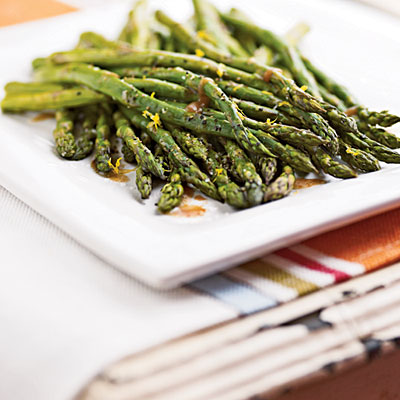 Randy Mayor and Iain Bagwell, Text: Jason Horn
Randy Mayor and Iain Bagwell, Text: Jason Horn
This recipe serves eight, but it can be reduced if you wish. I love roasted asparagus. We had them for dinner last night. They were the perfect accompaniment for wild salmon, peach chutney, and red potatoes with butter and parsley. Go easy on the butter for the potatoes and this can be a very healthy meal.
 Yield
Yield
8 servings (serving size: 5 spears)
Ingredients
- 40 asparagus spears, trimmed (about 2 pounds)
- Cooking spray
- 1/4 teaspoon kosher salt
- 1/8 teaspoon freshly ground black pepper
- 2 tablespoons butter
- 2 teaspoons low-sodium soy sauce
- 1 teaspoon balsamic vinegar
- Cracked black pepper (optional)
- Grated lemon rind (optional)
Preparation
Preheat oven to 400°.
Arrange asparagus in a single layer on a baking sheet; coat with cooking spray. Sprinkle with salt and pepper. Bake at 400° for 12 minutes or until tender.
Melt butter in a small skillet over medium heat; cook 3 minutes or until lightly browned, shaking pan occasionally. Remove from heat; stir in soy sauce and balsamic vinegar. Drizzle over asparagus, tossing well to coat. Garnish with cracked pepper and rind, if desired.
Nutritional Information
- Calories:
- 45 (60% from fat)
- Fat:
- 3g (sat 1.8g,mono 0.9g,poly 0.2g)
- Protein:
- 1.9g
- Carbohydrate:
- 3.9g
- Fiber:
- 1.7g
- Cholesterol:
- 8mg
- Iron:
- 0.7mg
- Sodium:
- 134mg
- Calcium:
- 18mg
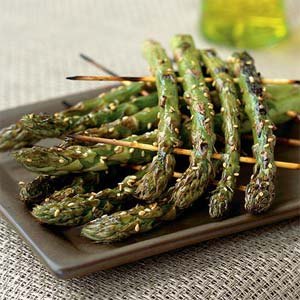 David Bonom, Cooking Light, SEPTEMBER 2007
David Bonom, Cooking Light, SEPTEMBER 2007 Photography: Randy Mayor; Styling: Lydia DeGaris-Pursell
Photography: Randy Mayor; Styling: Lydia DeGaris-PursellPinning asparagus spears together with skewers makes them easier to flip and grill evenly on both sides.
Yield
4 servings (serving size: 1 asparagus raft)
Ingredients
- 16 thick asparagus spears (about 1 pound)
- 1 tablespoon low-sodium soy sauce
- 1 teaspoon dark sesame oil
- 1 garlic clove, minced
- 2 teaspoons sesame seeds, toasted
- 1/4 teaspoon black pepper
- Dash of salt
Preparation
Prepare grill to high heat.
Snap off tough ends of asparagus. Arrange 4 asparagus spears on a flat surface. Thread 2 (3-inch) skewers or toothpicks horizontally through spears 1 inch from each end to form a raft. Repeat procedure with remaining asparagus spears.
Combine soy sauce, oil, and garlic; brush evenly over asparagus rafts. Grill 3 minutes on each side or until crisp-tender. Sprinkle evenly with sesame seeds, pepper, and salt.
Nutritional Information
- Calories:
- 50 (38% from fat)
- Fat:
- 2.1g (sat 0.2g,mono 0.5g,poly 0.6g)
- Protein:
- 3.2g
- Carbohydrate:
- 6.1g
- Fiber:
- 2.4g
- Cholesterol:
- 0.0mg
- Iron:
- 3mg
- Sodium:
- 190mg
- Calcium:
- 26mg
Storage In Small Bathrooms
Medicine cabinets come in every size, shape and design. The installation is simple and fast. Best of all, they offer both function and style for small spaces. The available space above the sink is often the easiest spot to add storage to your small bathroom, but the cabinet below was not placed in the customary above-the-sink position.
Blue and White
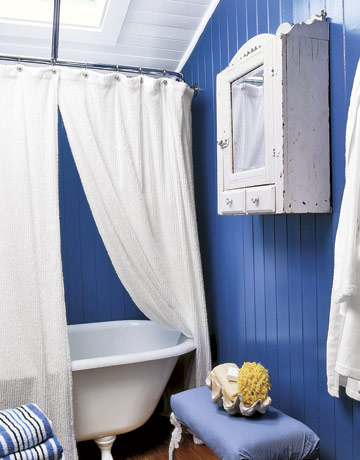
Beige, Black and White
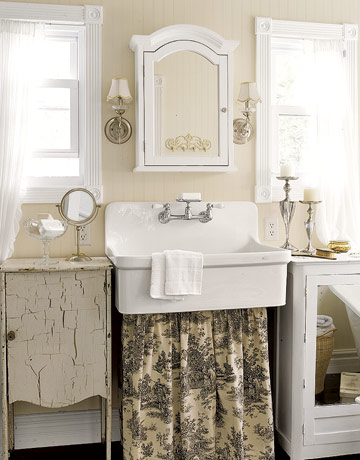
A little bit country!
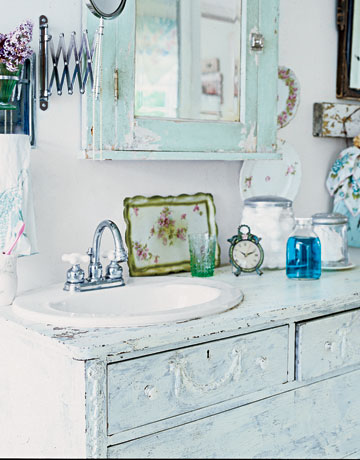
Twins

Source: Country Living